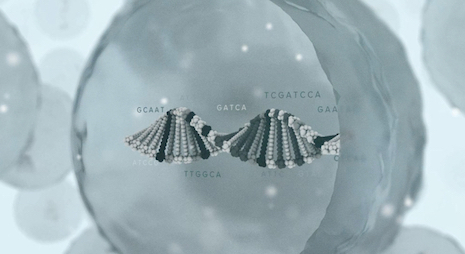Colored-gemstone miner Gemfields is providing peace of mind for its brand partners and consumers through a gemological paternity test program.
Gemfields’ Emerald Paternity Test leverages technologies developed by Gübelin, a Swiss, family-owned firm known for its gemstone expertise, high-jewelry and timepieces. The jewelry sector at large has increased its ethical and environmental responsibilities due to the many social issues that surround the mining of precious metals, diamonds and gemstones.
"Responsibility and transparency is at the heart of our business," said Gabriella Harvey, director of procurement and product services at Gemfields, New York. "We will therefore always welcome developments that improve the industry in this regard.
"We also embrace new technology and seek to modernize the sector wherever we can," she said. "This new technology is a perfect embodiment of this."
Proof of provenance
Gemfields and Gübelin announced their joint venture during Baselworld March 23-30 in Basel, Switzerland in the midst of new timepieces and innovations launched by fellow brands.
The Emerald Paternity Test relies on DNA-based technology developed by the Gübelin Gem Lab, a leader in gemstone analysis. Gübelin’s technology leverages DNA nanoparticles within the emerald to allow the stone to be traced back to its exact place of mining.
While at the mine, DNA-based nanoparticles are applied to the rough emerald crystals. Nanoparticles are so small that only an optical microscope can pick up on the elements, thus not compromising the appearance, quality and other properties of the emerald.
The nanoparticles are also able to withstand the procedures a emerald goes through before reaching the end consumer such as cleaning, cutting, polishing, transportation and setting.

Gübelin Gem Lab's DNA nanoparticles have a dimension of less than 100 nanometers
Gemologists can retrieve and decode the applied nanoparticles at any stage of the supply chain. From miners and industry watchdogs to jewelers and consumers, the Emerald Paternity Test adds a new level of transparency when sourcing emeralds.
Without this level of transparency, consumers are left with trusting a brand’s word rather than having concrete evidence that a particular stone is conflict-free. Gemfields emeralds that undergo the Emerald Paternity Test are then given the Provenance Proof label as a signifier.
Given Gemfields’ mission statement to bring to market only sustainable and ethical gemstones, the Gübelin partnership works to bolster the mining organization’s established efforts and exacting standards.
The Emerald Paternity Test has been set in motion at Kagem in Zambia, the largest emerald mine in the world, in which Gemfields is a majority owner.

Gemfields is the majority owner of Kagem emerald mine in Zambia
“This technology offers all stakeholders along the entire supply chain, from the miners to the final customers, proof of the exact source of emeralds, instilling confidence and creating trust,” said Daniel Nyfeler, managing director of Gübelin Gem Lab, in a statement.
“Partnering with Gemfields for the feasibility study was an obvious choice, as it is not only an industry leader, but a forward-thinking company, and hence a perfect partner to test a ground-breaking idea such as the paternity test for emeralds.”
To introduce its technology to consumers, both Gemfields and Gübelin are promoting the Emerald Paternity Test on social media to instill further confidence in its industry potential. The video walks viewers through the products showing the Zambian mine, gemologists in a laboratory setting and consumer consultation with a jeweler as a narrator explains the technology and its use.
The Gübelin Gem Lab proudly presents Provenance Proof
Per Gemfields, the technology developed by Gübelin is not suitable for rubies, but it is understood that Gübelin Gem Lab is working on alternative solutions.
A story to tell
A similar traceability feature is found in De Beers’ Forevermark diamonds. Each diamond is inscribed with a microscope serial number that can be entered into a portal on the Forevermark Web site where consumers can bring up the stone’s backstory.
As Forevermark does not sell through its direct channels, it allows consumers to research extensively before they go to a boutique to buy from its partner jewelers.
Forevermark’s “It’s a Long Journey to Become The One” campaign effort tells a romanticized origin story of a particular stone. The narrative begins with the diamonds creation and is traced from selection by Forevermark to the proposal sans setting (see story).
As the diamond industry has struggled to gain millennial market share due to changing martial trends and worries of unethical sourcing, colored-gemstones have emerged as a popular alternative (see story).
In response, Gemfields-owned Fabergé is prompting consumers to look beyond diamonds for their engagement rings with a colorful digital campaign.
Fabergé’s #SayYesInColour film tells color coordinated stories of proposals to showcase the brand’s emerald, ruby and sapphire engagement ring collection. While still an unconventional choice, depicting the women’s enthusiastic responses may help convince consumers to consider a colored stone (see story).
"Traceability and transparency should be a given," Gemfields' Ms. Harvey said.
"Consumers are becoming more and more accustomed to making purchase decisions according to the provenance of their goods," she said. "The colored-gemstone industry is no exception to this."
{"ct":"20oT+DA5w28+79psmtsffdfZAV73602DWiTXc1L46KYpOSaF3P0QBRj1Mq+PQWl++\/IPRLkifFuncFTkvhUaOIpjQpF630Z73jJozuXC0+Xr4o1sz8bhlNumEzYrX0U15FHaDo3yGphiak2BsZLejhmA090G8vrZgPNetdwkWrh7hxsCmgNF5a2R387efPTk7CFv7koAs6Xi3Pot5ljbkNZCZA7rewJbV+sZ4hELtoNwwdGyYyxaA0+VXvpizVC8Ywo\/4H+qltZEVSWhy2G3k5hhVCfNeR1UFr6sVV3TYwWa4ZOa0T2m\/TleuH6GVd94Qlq6BDqnHWaQt6dmTtblHW8Qw1\/64l6mdSO7BY3XA0SbuudJA6Fq3cXC7IfTV9LksxasjuykusvQ+NpALL7zqPhctrEptdE6vDwH6ESY4FDYnnP7rfNae6jVqO7FXqbb\/XJAyGe2hgz9nrmsbMRc9O9dJiXck0pIZzBZHzukn2c1M8nNU0xGr3GGqUC9pLumyOqO96sAKjmTTBvymSELAsIIZhR9pD9oqFYqBZdGJoKsNBjeXTQM72r4+1q+2lldn4yGW+IadV9D3mYMJG56YvyqGZjsoTqyb4w\/plPLySRDad\/1v2wodtaOcYR3Px8GH90jII2bGa\/LAus0K\/M16Up\/CJXoYltfcFEmnUIWHKa9KkmnHqKDWmIwDeMFjobEzF+ZKc0yeBMmw1ZvZg910aMeV0RfRP02N6o+PX+pOYFkTn2XIibC8n4BQtCsp831cepLaearr6LC7l0k+95U5GmqxYsdFVuy8KXUGF4OFbYLBOutfB2PLBmK2iZ1uEjInH72H\/OEZ0R8ePnoAkJkJ6u6YjYEPXMAfed6l3ykxYEM3a4DnoRJ4meXdE7iDwlNj5IQtfKjsBtZvxl1QSmblS01VQs9My3rGNcQH9tk11++gUqki7gHsU\/I2z4kT4rte4xHrDW6c9J2woCXdrBbDhbhuaV3i4gV4DIptRYlRb0F3m8r25rfv5NEInbHyw6qmIKcuKts570jzXa7iRId7ca8qO4eLOVf3FiP\/Z3pk\/EVawIgH2zEgLnwR7TwtZqcYvucUq+0VIFLmngAAQxgK4Wc86DKLpU0b641pTaifWbC1Vqou8GjcQMARWNDvcpw7UsDgiJ5tmQrSLEFzXiTKKgZWhU6LrwLbvMnexeyEd3YG38CZygOUNYGEeVk+mlblIVOdJxOKMOhLCG0qGuqrKHagaCKwytIP5TofoUvQMzsbIv5w0vWHOH45MzybsuoSjNC4\/5XD7ndb8tLLzDaoPUp\/utJhba+NBHXuD\/CruHvecyr1XTk+JNtwtdg6NvhcPgNfF6hdoLhWHkGkSQdeM8Na\/U3NuGJJsQKN\/skXLsr1pCQQ8hcIaIOdyPj+L0mxMddjhhURJQS4NMlOHG1Sguz\/OiZO6fNaztLQYg8caugKGo6id42GFdBnQGMXKFGGlysbKsAl38PbKtYloZQiMLWrYwugPlZ6l1fn9iTcZYmsHkkjNyq4QxXyyBLnaGUMm2FHBfWBrFpfkLwfU61RlQggyP6TETtbQtiwhkP\/QdunDae+sCVhXBRvCh3VmGP8PvT8ifnx0eE13Yk6iyg1sc80aU5jRdRT\/g+aN7NNM0sKiaN8eyjvTR61AaIRoQSvXjZ9mHqWMJwhHmCdFxzXylif9kKR850p08BSHHppUjpHTNz52S+SGsMlPSwBQR0mZ2SeIwj2HqJGqG76RAF4vp\/9HmxoiIg3Xc3CggakPvlJ\/RNqwykLwwnlhwoLZDbqXs8cgSxJ4pFNtEZwuDHegcOtg\/PPxZoS6kX+Xk7TtF4Fo\/aB7sCMPPF5YLBOGWh8dkZ0T0dTVGcHNUOzOyNzOMLyNnzC30v8qYji7Cm\/0juMm9TEOSuQK+4QOk3N89LxekWxox4lhApNU6OiegOc9L5qKCaETs2CD5kX5YzwWFim3mmpo8d9BwhKD0QBEdk9lPQcMlR0zg9O5OCpDdTsJggoYw9Gmf8xgO5is1V\/D3hK1CHu70IS9PTmQR2V51DdAdG5\/dn1Jj9vB3qGemPP+3xJt3JiUW19VTLm6xQzGwXZlwoeXKNKW7yEEke6GBWfIHTe7tC9tjZlaCFqGSGiHUv2DhJEgIRI0ISrhHtJA+X5ajjB7L1HnuN1DSdM4DcpA\/Jqhylxj7toNOkN7i8snj02\/\/yln3ELMZvwYx+iFUdinhn3B9VPjmZ0j0vAQqM9T\/R10UT6v8ezIMEB0bSWChhCCwQU6O92vm+D0l1AeynmIN+pjB7TtCHKoYn2l8s\/rNFD+i0NzdyfcP5fUgZdFli6aRVcfvRSM6vufyDeMTVB\/Mfo5AfkAbuL1AtY\/qhNhkfoSAnu\/pd2dCLeggjERnW94HgqhDnfwOLxWs7XvP0XxElRPKyJYagn2DwM4EcFO6UON715T5Im96F6oKsaUzhP4fgJZYVSfJdn+if8X6kHZd6WfUjVyeNIOpmp8s0YRPgSPvcSW71dcRCm40PAFGh\/YwCeli6mU\/9alE4EUvUfg2Xvsyw\/xPWo+cGT9vZI1RHfftzGlhpqd4c0mDOiiWfFj+NR4lv\/cT3X8UGFnLCtFHhna1AbPBetL6jqlE89njAT2xsa1fUaLROgD91yrUXQ9leYsI2wlsZWm1r9n9d1EMCYvn\/yjDu+r6mwOZtH9eEo+9q5eRx5VAqOWBlq9bMwSVBNcXkJAMuYD1aS5LlYUUQuC2oponznKAys+l8rhSqgklQg4GNGceoqdZyZ7tIH13QcoP+jB2cjD6HjuN8296cYeFiMX7nfpLZKSKdAKZLUUZGL\/lBLg4CDk5wxx4Zrs5gzI3TGy4BMNWt3WQmhc1G4cDvpi+ampIdCRMkW+fxBypc6o5CAzm+DnajW0EvP4rEAey6OJgFFjE6ZO5Z5n3kn+0yD86h14s6a\/DJbGtj3+mRm4q49kgcpoFkd497b5MlmlUi5T9cu5c\/cPAZAQiwvgRfry0ynoOPJFo\/dy2Inj0BpDYMoqOGsoq\/olVRJDPD\/44Ms4DObCWE8\/OsbOJ0fXeXallgOSZ7PuMVMLaiQnW6jDVE3RPIAQV7xc9WjK6qYVXFcrJwL4J3+fEZBt0CNwcI2y7VGjZImTnbfQCmlzZ3m6EjRV61k3BochDTUq15eZ4AMS3Ih19SOXOp\/KJExHmOnFZbD57r\/GQG28fZA4nuLFCNYYQXY8k2Ciy3+8GYxohqVbV5OGFbQkOSw7mW++4mPX5yhAmuFDEhlDq9Y9ulEeoMZbk+aWXE7beSHeMjpDeGsAoirt+fjm3iZMThBRfbN6BQgYrSIn4RWvwVVuYiCAF7Xouvsw4by4PMMiqmkeRg6C6FSMtFpHw7oP2BDCfiFOGRFNbCCldkCbyhiAQGzkBrUcn0v+y1dB\/eekhyydFanYqITOT\/f0CRED6kctjaa22bLuqK9kIYxXObh1ArASoteO92ol0bfiok2qQZWc\/\/1BvhdPG5h+8Orb7X\/BP731CDDxHcJ\/rpvAtxnkH4hfvCg7Lkxltd1BL5Lt5o4dU6rTkGYRgvhPu3VtKiXFyK+mOuqnk7LZkMA\/DAvRTPjHnnbYZIxfPu1+yC\/hoXiDCzsMeY4aqEVomRFlDWxvaVzH+Y0miQVeU925xXVMws\/uVZchQWZpMsveVvJyKwfe7HuELDzaiZPYAjsSk\/OUitZsRJLuS+qIRXp0g+dYKzb0FbbSJOQWJbbRQKVdCmbPemFkrbgI\/goz0C\/Zh07PEMS3nm5uobiMkp8zHngLPj3HHJT0ZvQuNBv1V\/PgLKK6z2e5RsVxmcJmeWSIhmPDo73X\/rO1n85f+lhZ6kXLJ4jUIAi1i581eI7mPU6QwTGpqXTFUpWu4IuLJDQ1Q8HyDyqi1PIuQ7DjfsAVDwwSuYkQh76KWffmr+K5RTqGDP\/idx9Lp3MEOe68Ff5EmJq3eTLHD0vHCMLMc+Le5ttqVFT7fPj2dC2WUYTVZK3O60JG1woZ40Uqu6UfZwPtq7J2cpsztBTMAmTgXhwKR9kXM3MlYLsguKnqE00fUJcjcX+HBe8sBougYe9qM\/ypmaixv4QihpwU\/FcmcVNKOVoktScPPmxd6QGZb5a4mdefnT1tY+6Qavh+2fdy3pwlL8wheAF4M92mOBaNxlpBN+SERQ3BRDjtBtTIsrVn+w7nKsBsWMet37VAzsaUYntsqfPNDV922F7bzlBI0iC4c8qELosRWBIhUhAiHE2yiQOtlW0rwvIfTrgHvhHdCu9VTITghJVaPS6e8bp+ApWquVkyQg5yNhb4DUfq1GVijpoH3URsaN38AfduprvqKA4vOlOjwVEI1qJSoCCBtRcHJA9fMqweqBYvkpWh04LS1U3SXDkyQJBIVMRsPRl1XY0OVWUbSKf2sRxLEFwLoL0nLwAX4WijqEWZ+NNXOV4kqVcA+e\/Egt0F2AgDCb07HTQ13n6E\/ddfLaYnL9ekuTQ\/eTcc64MOedA28qGyhszFTeOb1ZWtiNeFP+b0QF56nXeUHyzeGPAVkBeAXMzkCTIba4ssYZ\/qnP++Onsd9BfRMv1B9jKNsjiuR3ta+URPTAp+5px48jFAltL4GrtqmQQvDYg\/Fj\/c9aB08gxrJiGDGn2WH28evXzm6avEbAUHD3RD8dJS\/U1tacaQEYrCx72yWBq2a6a2QC+UuDZpT85IAggVJs9LNBhalNJ4ohYgeseaWyVQwdvS3S7zYX4m7vpsUmuISSY3v2n2Cu3SyxPykeWWVVN5eajcfRxLqrQiU1OSO36kthtKfFSK\/BhMs7ktX6J\/ouIljns6WSopPt1CLWDC0VauenA364tqqY94fwFqVQiMUTJhkZSsY7YlgRS917Z4LZD09rg968xmbaEEjt0uiFRPlovK+f8hySj8PKFApVhi7HNJBt8JtbQpZK4\/owc1BE1VzQPCHrkZUSqA8pV+VCZ7vhwsIwdhn1iR0dWTLPcsQj7VpVlG9caXiq7pwDVf4Pc39qz9lOOvb3czxbMYV1rRRWBJGaRez3WV\/w0B0cbjEdmhaRpvpgAUxnClWCADgCssFu1KLiLgaScDjl82ltUCd9cGz7aj9z0Jezs\/EQhg5kR2q3yAw8RBufMsMjMJaAnZFNJeZIFm1YMsp2F\/qvdYZgybDTZxCwjyxPH6Y+LPVDggbVvSieGNhZWR6kd13Mgiffmc5OcPqFY4aqIGZqOEizUaEGhG841swtS0COD5ZNMNmSrE6r9WxH+4\/TFChmNEt4fO8bawPWcFYaRhDrbJQaYp6hp7DMP8wXTU54S7IJYWGF7VGr206JZoU8o69C+gQ+9dcyhzPt10u9H1ItRFMjRdlZtlxxBkX9Ifu1NHqoSiGtNkrpJ0nFHdTRvEFL2ShQE\/H1KRGq7i8onlf055YVKFVfOLQERlHrsKGo0zraAt\/ij5MWGleDBlT0z+0k8GqqUEkJ8\/+muqd2SjYo75ZtfJFtut\/rOr7mU5KlwJ3noKtqMB9nbrG0tMb99YU\/KnlsfV6Gq5RW+6lnDXmoMadIXteIU46dWA9PrC+fqI2pakp4tCZpi6D50bapwTaFJnk\/EpRxz8E34F5IDceJjAQC3IvNYygRQ1LgIbhAZNsT1RaQJy7LcHZWd7Cah2gwUHkY4nBKYlQqTkVRI6ibypxlm+brv0+GgIucIIjKlQxntMiEK2oZn4WIhnab2ApR5DWPQyzcRupruY6gLvf2RwSV3G5aAH\/JCD\/rXpSBDHjT8hVVZcAhGGbZNZSFEGAb8i2CJhRdtzwPujwcrQSbEUrQXMvwBHXUrMoQWFWTlDxsvlXW7Sl7rcOiEZsYlllFfJi+PCMfSy4T\/Ulz7K3V65AqhSAGd+OPsl8jp\/VITc6M6HzCTgGNbojS93ixPDw4FNuTr+3q2czKzpoVUx5ARapGXz288yA1XFrHlIpYeZqmTP\/SF0rviKL2Y9lUCtcvnALi6tCuDLBdJdoxDz2Tp8jCdu+TUVKZ7hRJVSXVWsdoKOV\/qWU3qAzGKmDJ6gBeU7Vii1xNaHEVvvoRoDOy\/AwheixZalB5+VMR9gxkJdM4w+4DnqDZ6Kb6WpE6YbAh\/yb8IgCMEsKBp\/6EKCprYx8uuzIVOEzom7cqLHpGpWjKWZr6tKfnH57SKDG73NoMkITMUxIGi4FBwCE\/3h\/1qwwDpLBPryqylKGF54UubE+jVtpD83bTwI20FiqCH\/58+VCvO15b62wrx56CyKNaz0PEual8Tyb6RH2uRmbThZ55NgCcbbUgyeRj+yPUWqN\/C2Bjsl3DC2mJMevYOKvwddaAlpje5fuBRj4\/LYtGzmh57VKdn7d6HfXqtgUJlmuqNzhf3Er6WY\/+fdRDmcw4B8tJb55auvbLBdGts3MhuD5oW8jgeOaj49bAM5KJiHUmgIy0Rb43orD9onFBABpotg6l020yUUlMel2wtBHsSkYDJO3RChZr6G2KYLZpeMXcmzAXP\/YFMgEh0huzIhjXeh7SGiC2asJ8CDeT+E+Tf\/RRLt0W5G5nqN4WMj7MPU9lq\/4DZ+tp8tiQAZ29kGS1ETWm6XkvFQbI+LkKcF04BWVE0umV6PsmtreXyFxf3uFt790ZLJqwaSicNHWxvD20GZxnLZ1dtsBXaItKkvne3zH2P1O54U2f1nhOw4R4Ps5LZg0HD35vsYrdpuWCPHoL3VGlPn0EHb9EwlkRSAKOqlQM1RA3sacEPwepUoXXYUOTiX2sEhEWafhocboqsCAi3niF3tTQGciGcq2w35WJgAcSQwRJZugIXWpOBD+e+NXFMFoaarKgk41mGolN8DvV+3QeeS4H7mYMNu77n\/hfz27ViNgPHxB3tcl0fRgNWOPUB2y4ZYEBdy71aodpj0AMBE0itgEzJ\/ZayejWRMsyRcWlrctZtzD5WZ6nIms0f2UEDchmgxicPL1e8IdPBQANhAGNUVaDfJg4E9o+GRc2zM5Q9WlSROZTuMpmGYUBzsFbQWouytykO8QJWeJ8v70s5IyDjTOVArAYIfgsjEIYgxT31oQKkDz452TvOubFBh0TBNuVoDNWTyM86xUM2ByZZNwiMiZoIVwOB5oNI7cks6o\/Mw1XUvi9VzOq309N8KLf7CQBje1\/v1vL3wkEHRzRi2eYinGX41+nfv1tZPucFZroy3BdolJk14JWYTMkuK70O0qfc9yzqoBMJkSu5LTo4oVOwyYvmfWH10tlPtTqiXBPfzc1KjYSrcTtqt6ug1KbXFHZKfJlSkBEUQ+soJGrWVY7Ui52E26v6g3UtIZQAojPb0rT2siBcuMfIpv4lmjmGLT4XDifFEBxvg1epiXczlFX3tg1V\/SSLzdxer2zbA5d\/wUdJYZgUhOUTZZnMZrRnYXL\/O0bQz4IFiODh9JJ8EEP0E2ss8uYFP20E\/JtkyLJMihnCQEEbV20ZhhZjgv31\/\/GCMhLTNAc2hmdDJF3AsGOxWdYWTlz2MaQroyJZ5AGq4kl\/+CIfNiL6ZybbAwMkugn0hz9jgnoaEuhXqN+a62nlZOklA2yDX2hdKS7MrKyGlE1qQeO0bOHJ5OTlsP2gE3PHSP1JBK3WiTfbjhNML\/dldmOFDwtb2NZXUAniQ8\/SXpeLLC+CcIzmPMrW72gV8QKVSDvXiaKQCU5pOWwqUgpjblQlGTc17HKn0UwzcIQQpdosYh6fDP+GNMEsCJy7O5nbkZKaSNZhuBamrOjlNcj+ZG50haZp28LabzSexkBI4oev0kmF2VYax5AhVBnHn\/QSSD5as45M0rGhH1mibnTdoZvJwFTWS+HQTuziwOAULWXEPABF\/gNIHgoEJEODcQyO2weiBgKg9LrgYqq2qUmL2lExr+eeSx65cN1gAAIyAWGrPc+TmS+w3SxxRsyWxM\/eIXibkoxU6HwV2IvS+TEg2jvXMcwHu9kQa\/jPfZ4Xv2vaE+QK\/+xII1rwbeOFgvj3S9Ar9z3U4XNhlpXnNkUnVg2xXOIOk5loV2kM2oSlbUMkZrZLZneg3jrroHNdlYo702ThDWnqLW3N5yXfTv0O6VepqiZmY6TJAIGEDbjF0Rs5buvtDy\/QsBkmzUcSSbdhY9s6gYj2+UaXUdF3aikliJFl4vQQU\/bAaQMe5CwRAa2xhZnFRwqJJG4b5tPCQdDV1K6kyq61cw2kApMa9NH8ZJb51BrKR8pa5OL++KpR69j06cvfZ0IRydpF2DRSb4CtFTh8yWY88PzJkCRhzhj9DszsYuzYFCKwjTxPcme0lTv0qO0mWwXLEXmlDgGYxpbuz1CKAVHRyxfJhTMrWWYUqT8\/vJ\/a6j3Hr0ktoYCBSIxueJDVST25LYQCXXzZFMMKyUOA0SaZjVOVyT0g5zCJ2hZ5WAV9ZyR3AwRkC1t9S+nOwyr8L1PSz9LLSPuH830YvBDqLs61a2DtGVQ52\/0rRQV1pEk6errDwkUgJHYxlwT5vYPhHYi7ZD+EUIe8S7MUGLYtnvrtozItWS3mRU0zRYO+hck08Iiu8+AnIKdIWCMTQVPjbu3iE8kIRB8BLNrz9qk4U8ZMjjd\/NU3JqSum8MiYxCcg0g4ZFpqEGIhd62fRSgtZw+vcU8cHTTV6lxGDS2mbciczEjPdBpH9iZg7uit+ADRL0g3Bw70CzDNts6Zyv4DlUak0xr7506NBPAexRXfZEkd1+Tz3r+2zJxNXpInGbXnjIJJY6\/dBJZqQDsRLI1iQSjSfCKGNP\/MsFm2z+XHHagmx2mdWOHaoYWYM5Ce7nP6HqFXxAC1S3fSypRiWsZNwojTssu9fdiDlb4MLZdBwKVW2USElc5VBJhmeDKnF52k3tf3qC2UaakV7KMO4oWLzS54nnL9HrxuNxQb59OGl6DbgVfAWZXuHpzi3A03Ro9ezxhK7iWL2k7yHFxHVZNq\/yNKWYM6duTgUMMKTWZVfFHwND22R21wpXkNWJxs7iq7FjUpsrH9CzpKydV9nn69kPcQoDQ2w6Y49S4XQHTi81M+s6aYiJJyPblNq62PnUu0n+WrVO45N0SnU7vYpi+Yv5b2hUL\/jFzXL\/gwSmChgSfkzIEssGSG103XYqk+MclJGiXQmxsT4n67gmGczxUS+51dsVuz1QAma77skVNGadWcHvI0gboROgUgPn\/TxGPR7lMPWFRZ\/20vt9MEDfjpimvQjq+Fn1noXmKdqa4QSjuQ+6s3wMwYUkvcJZs1jafS2rAYnj6yIr1gZ5KhSJr7r1Sp\/\/\/efl9OucK64ZTMJmc7S4dD9+Jf4XhXQydkO4kLnKBbPpPdVn7hjWBiZcQrHSbAz8ePAVxjFRkr5oKZsWL0JWMtCx0Z7vPAjYdliggaimAMNlZxXu9eYT8TP40HPuUvDGsET0Up7Z5HTDx7ZOtcgyoWAQxyx5WVy1EaojCzoh5UNclABqgvrEauTCyrPkqVXgIA3LSXCImSxgY22FGub166raKlHxTydk\/Z6tKpbZ7Qy4ukhHf2JMB9SScmlDrQx6xaoFeXr0ORiUmvRvzsBqOA\/YXSwrJ7C2SvYz+DFHcOW9PSyVBQirZH1KyThYS\/fZ3mMRX5PJYfuXUEtwiEYI029sHgA7HrwZvyQsZoeCJclKHSXS9R3ngKkfLgMARY8c5uxYr3cSzXZZasV4XpXciTf8582MFGCbMSOy69MprA\/qefhaJ\/r\/xVyD3isrAcdTOzRHXzmo9VMyou1GUKZ89dHEeXMAF1aFPuaQBVXYckSo9JRcaB7Go2Cd7lufL2Zb7RGu8CegzcPvkRK9D5vLKYPzgH4OlUiiWY4sGVf4IPrGWcD6oZ95rqf3nIHTSTqLs\/1nbf1xL6+g0CxO4MnNSenijEJmVpoG7jNc5KNZs4Y8ohqRz0wmtQyn8helE4F7cV0G6RnUpH6zsXpKwG\/2iEMJeV0LWhKdXP8I+u87014VYu2+B3JJog+BoFAkuPC1eCO0Lgzt2jRItbjV1GgDRlZOfAcIu4QI399EhC\/dHZZIUqO8G9GNtycXg6UKecS1+O4o4EcZVJNPbwc3ZGAyW2jIquGbEfKdMOtK5Olzr5m2eZuIf\/xFMwz9sH6qSh","iv":"117ac5cfbc75894baf1223b944b4b1c5","s":"d7a6d9e013d898bc"}

 Raw emeralds sourced by Gemfields
Raw emeralds sourced by Gemfields